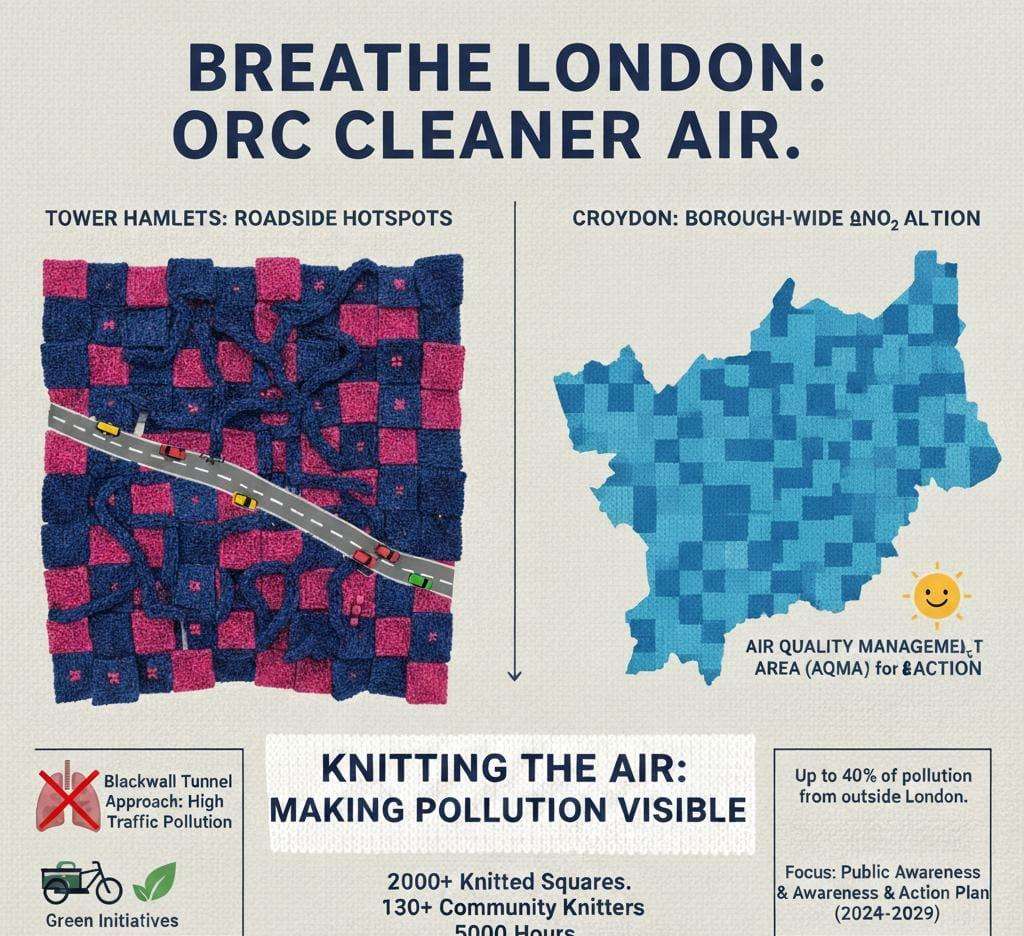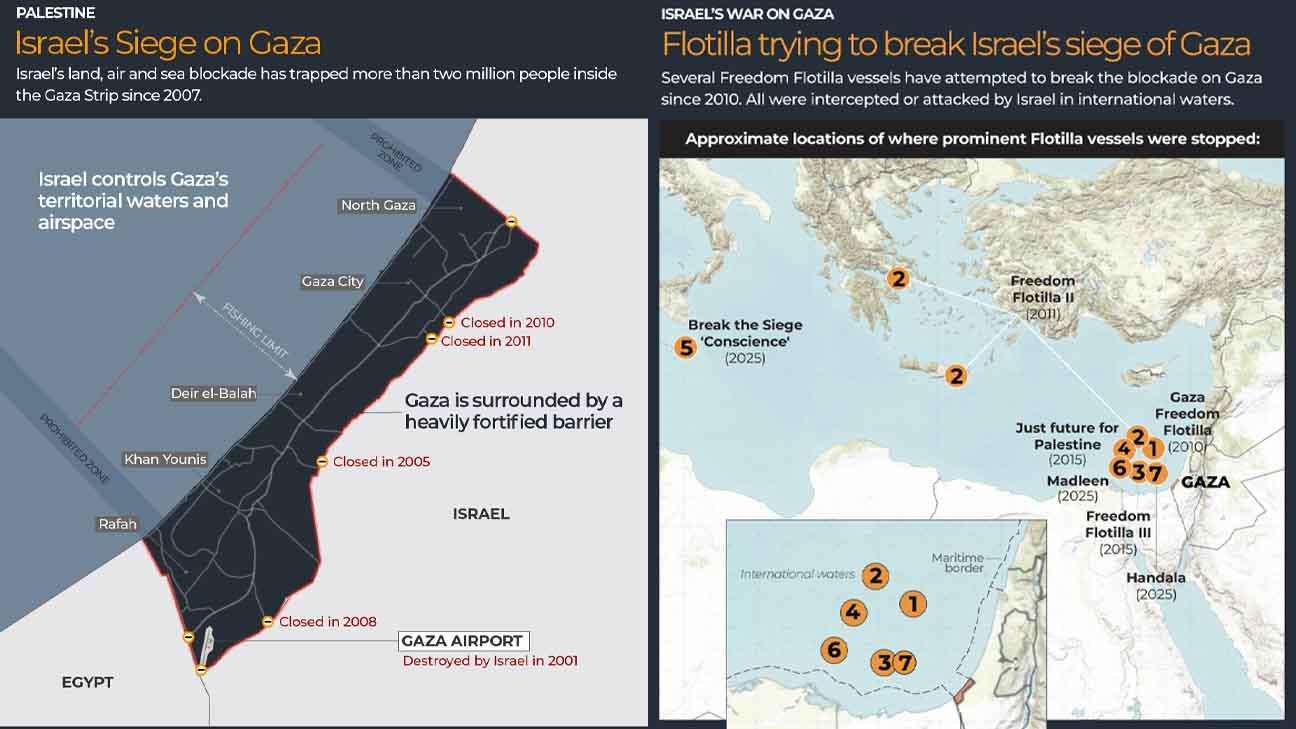Poplar Community Weaves Air Quality into Stunning 12m Textile, Driving Awareness Amidst London's Uneven Pollution Landscape
In a powerful display of community engagement, over 130 knitters from Poplar, Tower Hamlets, have unveiled a striking 12-meter textile artwork titled "Knitting the Air." The magnificent piece transforms a year's worth of local air quality data (March 2023–March 2024) into more than 2,000 hand-knitted squares, giving palpable form to the invisible health threat of air pollution.
The project visualizes readings from two local Breathe London Community sensors, using blue squares for \text{NO}2 (nitrogen dioxide) and pink for \text{PM}{2.5} (fine particulate matter). This unique fusion of art and environmental science, which involved over 5,000 hours of knitting, has been lauded for making abstract data "tangible" and easy for residents to understand.
Lead artist Caroline Murray noted, ‘We were ambitious from the start: to knit a whole year’s worth of data from two sensors... Their 5,000+ hours of work represent not only creativity and dedication, but also deep community care for the air we all breathe.’
The London Air Quality Divide: Tower Hamlets vs. Croydon
The local data visualized by the artwork, particularly from the sensor near the heavily congested A12 by the Blackwall Tunnel, reflects the ongoing air quality challenges faced by Tower Hamlets, an Inner London borough known for its dense population and proximity to major arterial roads.
Generally, Inner London boroughs like Tower Hamlets tend to experience the highest levels of roadside pollution, particularly \text{NO}_2, due to traffic congestion and the canyon effect of tall buildings trapping emissions. While central monitoring sites show a gradual improvement across London, Tower Hamlets remains a focus area for managing high-exposure pollution hotspots. The borough participates in initiatives like the Mayor's Air Quality Fund (MAQF) through the Zero Emission Network collaboration to support e-bikes and cargo bikes, aiming to mitigate these roadside highs.
In contrast, Croydon, a large Outer London borough, faces a different challenge. Croydon Council has declared an Air Quality Management Area (AQMA) for the whole borough specifically for \text{NO}_2, confirming that they are failing to meet the EU annual average limit at some monitoring stations. While pollution levels at automatic monitoring sites in Croydon have shown significant decreases in recent years, the borough's Air Quality Action Plan (2024-2029) highlights that a substantial portion of pollution—estimated at up to 40%—originates from outside London and Europe. This necessitates a focus on both local action and raising public awareness to reduce exposure, mirroring the aims of the "Knitting the Air" project.
Best/Worst Comparison Focus: While air quality fluctuates, Croydon's borough-wide AQMA for \text{NO}_2 suggests a more pervasive issue needing sustained action across its geography. Tower Hamlets' challenges are more acute in areas like the Blackwall Tunnel approach, but its location closer to the central drive for air quality improvements and diverse mobility options means a greater spotlight is often placed on mitigating these roadside hotspots. Both boroughs actively monitor and implement measures, yet both continue to struggle with meeting optimal air quality standards for key pollutants.
Updated Air Quality Context and Related Information
The efforts in Poplar come as broader reports highlight persistent air quality issues across the capital:
\text{NO}_2 Compliance: While many London zones are now meeting the limit value for annual mean \text{NO}_2, central roadside monitoring stations, such as London Marylebone Road, have occasionally continued to exceed key targets, confirming that highly-trafficked areas remain the biggest threat.
\text{PM}{2.5} Focus: A major ongoing concern is \text{PM}{2.5} (fine particulate matter), which, while decreasing, still often fails to meet the stringent World Health Organisation (WHO) standards. This invisible pollutant is directly linked to severe health issues, including the recent news that exposure to \text{PM}_{10} can worsen sleep apnoea and that the lung impact of indoor wood burners can be similar to that of cigarettes.
London's \text{NO}_2 Reduction: Mayor's initiatives, including the Ultra Low Emission Zone (ULEZ) expansion, have been instrumental in driving down overall pollution, yet significant work remains, particularly in areas like Croydon and Tower Hamlets, to protect vulnerable populations.
The Health Connection: Local GP Dr. Emma Radcliffe, a knitter on the project, emphasized the medical perspective: ‘Clean air is one of the building blocks of health. We know our patients have been breathing poor air and that our community suffers from worse health because of it.’ The "Knitting the Air" artwork has gathered over 400 reflections from residents, demonstrating a powerful demand for political and community-led solutions to protect public health.
The knitted masterpiece will continue its tour, with plans for a larger East London exhibition next year, ensuring its message of data-driven community care continues to resonate across the capital.



_2.jpg)
_3.jpg)



.svg)


